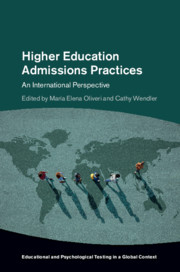Book contents
- Higher Education Admissions Practices
- Educational and Psychological Testing in a Global Context
- Higher Education Admissions Practices
- Copyright page
- Contents
- Figures
- Tables
- Contributors
- Series Editor’s Foreword
- Foreword
- Acknowledgments
- Part I Global Challenges and Common Admissions Models
- Part II Country-Specific Admissions Practices
- Part III Assessments Used in Higher Education Admissions
- Part IV Rethinking Higher Education Admissions
- Chapter 17 The ACT Holistic Framework® of Education and Workplace Success
- Chapter 18 Using Mathematical Models to Improve Access to Postsecondary Education
- Chapter 19 After Admissions: What Comes Next in Higher Education?
- Index
- References
Chapter 19 - After Admissions: What Comes Next in Higher Education?
from Part IV - Rethinking Higher Education Admissions
Published online by Cambridge University Press: 09 January 2020
- Higher Education Admissions Practices
- Educational and Psychological Testing in a Global Context
- Higher Education Admissions Practices
- Copyright page
- Contents
- Figures
- Tables
- Contributors
- Series Editor’s Foreword
- Foreword
- Acknowledgments
- Part I Global Challenges and Common Admissions Models
- Part II Country-Specific Admissions Practices
- Part III Assessments Used in Higher Education Admissions
- Part IV Rethinking Higher Education Admissions
- Chapter 17 The ACT Holistic Framework® of Education and Workplace Success
- Chapter 18 Using Mathematical Models to Improve Access to Postsecondary Education
- Chapter 19 After Admissions: What Comes Next in Higher Education?
- Index
- References
Summary
This chapter provides an overview of changes in the higher education environment that inform admissions and placement decisions. Various factors that must be considered when reconceptualizing current admission and placement practices are discussed. An expanded assessment framework based on two models – the multilevel design model and the complementarity model – are described. These models aim to better support diverse students’ learning by improving the connection between assessments and instruction once students are admitted to higher education institutions. Finally, the contributions of technological advancements, measurement of noncognitive skills, and innovations in task design are described.
Keywords
- Type
- Chapter
- Information
- Higher Education Admissions PracticesAn International Perspective, pp. 347 - 375Publisher: Cambridge University PressPrint publication year: 2020
References
- 2
- Cited by

